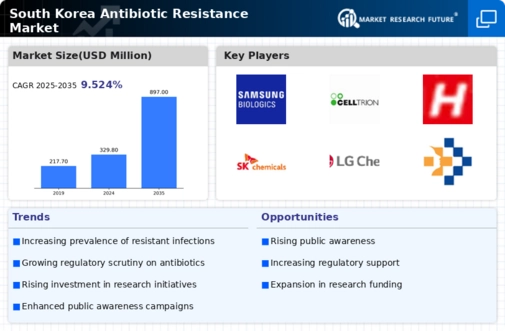Government Initiatives and Funding
The South Korean government has recognized the urgent need to address antibiotic resistance, leading to increased funding and initiatives aimed at combating this public health crisis. In 2025, the government allocated approximately $50 million to support research and development in the antibiotic resistance market. This funding is directed towards innovative research projects, public health campaigns, and the establishment of antibiotic stewardship programs. Such initiatives are expected to enhance the overall effectiveness of antibiotic use and reduce the incidence of resistance. The commitment from the government not only fosters collaboration among researchers and healthcare professionals but also encourages private sector investment in the antibiotic resistance market, potentially leading to breakthroughs in treatment options.
Impact of International Collaboration
International collaboration is emerging as a vital driver for the antibiotic resistance market in South Korea. Partnerships with global health organizations and research institutions facilitate knowledge exchange and resource sharing, which are essential for addressing antibiotic resistance. Collaborative efforts have led to the establishment of joint research initiatives and data-sharing platforms, enhancing the understanding of resistance patterns. In 2025, South Korea participated in several international conferences focused on antibiotic resistance, showcasing its commitment to global health. Such collaborations are likely to accelerate the development of new antibiotics and alternative therapies, thereby fostering growth in the antibiotic resistance market.
Technological Advancements in Diagnostics
Advancements in diagnostic technologies are playing a pivotal role in shaping the antibiotic resistance market. Rapid diagnostic tests enable healthcare providers to identify resistant pathogens more quickly and accurately, facilitating timely and appropriate treatment decisions. In South Korea, the adoption of these technologies has increased, with a reported growth rate of 15% in the diagnostic sector. This trend is expected to continue as healthcare systems strive to improve patient care and reduce the spread of antibiotic resistance. By enabling targeted therapies, these innovations not only enhance treatment efficacy but also contribute to the overall reduction of antibiotic misuse, thereby positively impacting the antibiotic resistance market.
Growing Awareness of Antimicrobial Stewardship
There is a notable shift towards antimicrobial stewardship in South Korea, which is significantly influencing the antibiotic resistance market. Healthcare institutions are increasingly adopting stewardship programs aimed at optimizing antibiotic use and minimizing resistance development. These programs have been shown to reduce antibiotic consumption by up to 20%, thereby decreasing the prevalence of resistant infections. As healthcare providers become more aware of the implications of antibiotic misuse, the demand for educational resources and tools to implement effective stewardship practices is likely to rise. This growing awareness not only enhances patient outcomes but also drives the antibiotic resistance market as stakeholders seek to align with best practices in antibiotic management.
Rising Incidence of Antibiotic-Resistant Infections
The increasing prevalence of antibiotic-resistant infections in South Korea is a critical driver for the antibiotic resistance market. Reports indicate that approximately 30,000 cases of antibiotic-resistant infections occur annually, leading to significant healthcare costs. The economic burden associated with these infections is estimated to exceed $1 billion each year. This alarming trend compels healthcare providers and policymakers to seek innovative solutions, thereby stimulating demand for new antibiotics and alternative therapies. The antibiotic resistance market is likely to expand as stakeholders prioritize the development of effective treatments to combat these resistant strains. Furthermore, public awareness campaigns are being launched to educate the population about the risks associated with antibiotic misuse, which may further drive market growth.

















Leave a Comment